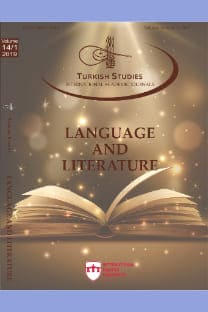Knowledge Complementarity in Simultaneous Interpreting
Simultane Çeviride Bilginin Bütünleyiciliği
___
Anderson, L. (1979). Simultaneous interpretation: Contextual and translation aspects. (Unpublished M.A. thesis, Concordia University).Dascal, M. (2003). Interpretation and understanding. Benjamins Publishing Company.
Díaz-Galaz,S., Padilla, P. and Bajo, M.T. (2015). The role of advance preparation in simultaneous interpreting. Interpreting, 17 (1), 1-25. http://dx.doi.org/10.1075/intp.17.1.01dia
Dudschig, C., Maienborn, C., Kaup, B. (2016). Is there a difference between stripy journeys and stripy ladybirds? Brain and Cognition Journal, 103, 38-49. http://dx.doi.org/10.1016/j.bandc.2016.01.001
Gile, D. (1995). Basic concepts and models for interpreter and translator training. John Benjamins Publishing Company.
Gile, D. (2001). Conference and simultaneous interpreting. In M. Baker (Ed.). Routledge encyclopedia of translation studies, (pp. 40-45). Routledge.
Gile, D. (2005). Empirical research into the role of knowledge in interpreting: Methodological Aspects. In H. Gerzymisch-Arbogast, J. Engberg, H.V.Dam (Eds.). Knowledge systems and translation, (pp.149–172). De Gruyter Mouton.
Hagoort, P., Hald, L., Bastiaansen, M., & Petersson, K. M. (2004). integration of word meaning and world knowledge in language comprehension. Science, 304(5669), 438– 441. http://dx.doi.org/10.1126/science.1095455
Kim, L. (2006). Use of extralinguistic knowledge in translation. Meta: Translators' Journal, 51 (2), 284-303. http://dx.doi.org/10.7202/013257ar
Kościałkowska-Okońska, E. (2012). Translation professionalism and translation quality in interpreter training: A survey. In by L. Bogucki & M. Deckert (Eds.). Teaching translation and interpreting: Advances and perspectives, (pp. 93–107). Cambridge Scholars.
Lee, J. (2008). Rating scales for interpreting performance assessment. The Interpreter and Translator Trainer, 2(2), 165-184.
Martin,C.D.,Garcia, H., Breton, A., Thierry, G., Costa, A. (2016). World knowledge integration during second language comprehension. Language, Cognition and Neuroscience, 31(2), 206-216. http://dx.doi.org/10.1080/23273798.2015.1084012
Massaro, D. W. (1975). Acoustic features in speech perception. In D. W. Massaro (Ed.). Understanding language: an information processing analysis of speech perception, reading, and psycholinguistics, (pp. 77-121). Academic Press.
Pöchhacker, F. (2004). The position of interpreting studies. In C.Milan and F.Bartrina (Eds.). The Routledge handbook of translation studies, (pp. 60-72). Routledge
Seleskovitch, D. (1977). Why interpreting is not tantamount to translating languages. The Incorporated Linguist, 16 (2), 22-3.
Setton, R. (2002). Meaning assembly in simultaneous interpretation. In F. Pöchhacker and M. Shlesinger (Eds.). The Interpreting Studies Reader, (pp. 179-202). Routledge.
Wu, J. (1994). Task-oriented and comprehensive training of translators and interpreters. In R.K. Seymour & C.C. Liu (Eds.). Translation and interpreting: Bridging east and west, (pp. 85- 98). University of Hawaii College of Languages, Linguistics and Literature.
- ISSN: 2667-5641
- Yayın Aralığı: 4
- Başlangıç: 2006
- Yayıncı: ASOS Eğitim Bilişim Danışmanlık Otomasyon Yayıncılık Reklam Sanayi ve Ticaret LTD ŞTİ
Fatma Aliye Hanım’ın Refet Romanında İlk Dârülmuallimîn ve Maarif-i Umumiye Nizamnamelerinin İzleri
Rabia GÜRBÜZ AS, Mehmet ÖZDEMİR
Modern Kentin Çağrısı: “Terziler Geldiler” Şiirine Hermeneutik Bir Yaklaşım
Developing National Standards and Qualifications for Sign Language Interpreting in Turkey
A. Zeynep ORAL, Ayşe Şirin OKYAYUZ
Simultane Çeviride Bilginin Bütünleyiciliği
Nilüfer ALİMEN, Senem ÖNER BULUT
Kültürlerarası Etkileşimde Rusça Deyimlerin Karşılaştırmalı Analizi
Modern Özbek Öykücülüğünün Genel Özellikleri
Türkiye’de Sokağa Çıkma Yasağının Düşündürdükleri: Yalnızlığın Oyuncakları ve Baydurca Bir Öngörü
Türkiye’de İşaret Dili Çevirmenliği için Ulusal Standart ve Ulusal Yeterlilik Çalışmaları
Ayşe Şirin OKYAVUZ, A. Zeynep ORAL
